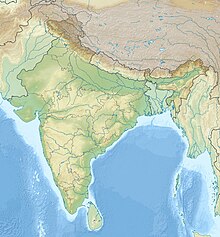| Khapra Kodiya Caves | |
|---|---|
 Khapra Kodiya Caves Khapra Kodiya Caves | |
  | |
| Coordinates | 21°31′48″N 70°28′05″E / 21.529933°N 70.468088°E / 21.529933; 70.468088 |
The Khapra Kodiya Caves are part of the Junagadh Buddhist Cave Group. They are the oldest of the caves in the group. The caves, on the basis of scribbles and short cursive letters on the wall, are dated to 3rd-4th century BCE during the Emperor Ashoka's rule and are the plainest of all the caves in the groups. These caves are also known as Khangar Mahal. They were carved in rock during the reign of Emperor Ashoka and are considered the earliest monastic settlement in the area. These caves are along the edge of the ancient Sudarshan Lake (which no longer exists) and a little outside Uparkot fort, to the north.

The caves are carved out in an east–west longitudinal ridge. They are small in area. But the architecture of the water tanks is unique, and the caves form an L-shaped residence. Caves were used by bhikkus during vassa period. After many years of use, they were abandoned because cracks within the caves let water seep into living quarters, rendering them unusable. Many accounts say that after this, the monks left for Maharashtra, where they went on to carve many similar and more elaborate structures. Khapara Kodia was damaged by later quarrying, and now only the highest story remains.
-
 Frontside of the caves
Frontside of the caves
-
 Entry Passage
Entry Passage
-
 Outer wall
Outer wall
-
 Underground room
Underground room
-
 Underground room with entrygate to another room
Underground room with entrygate to another room
-
 Supporting pilars
Supporting pilars
References
- "Ticketed Monuments - Gujarat Buddhist Cave Groups, Uperkot, Junagadh". Archaeological Survey of India, Government of India. Archived from the original on 26 September 2013. Retrieved 25 November 2013.
- Sagar, Krishna Chandra (1992). Foreign influence on ancient India. New Delhi: Northern Book Centre. p. 150. ISBN 978-8172110284. Retrieved 25 November 2013.
- "Buddhist Caves". Gujarat Tourism - Tourism Corporation of Gujarat Limited. Archived from the original on 12 December 2010. Retrieved 25 November 2013.
This Buddhism-related article is a stub. You can help Misplaced Pages by expanding it. |